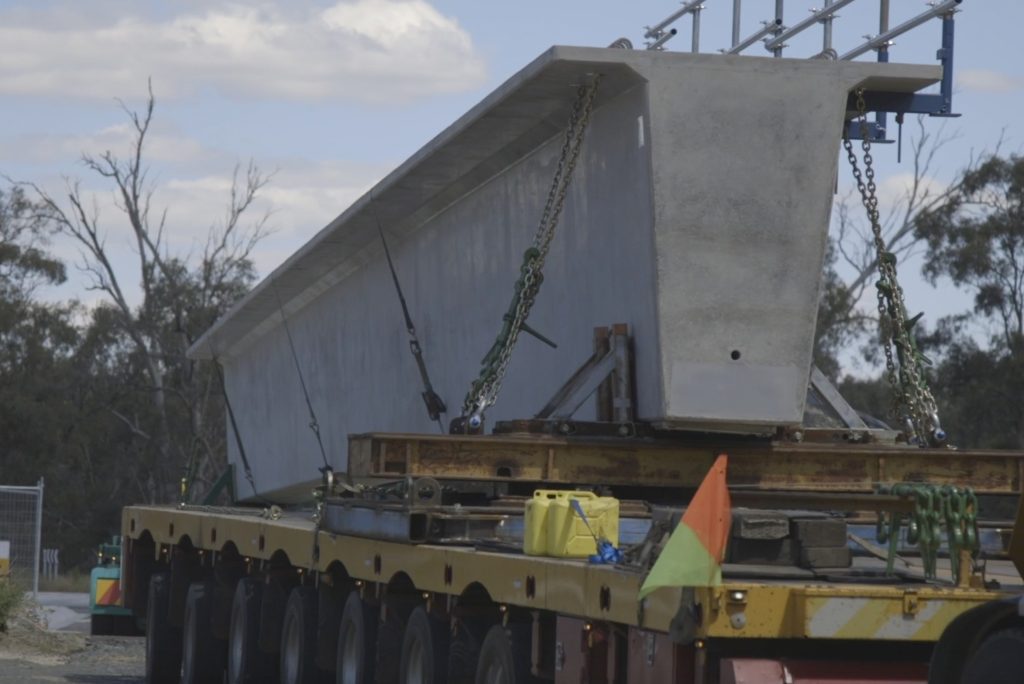T beams in Australia are used in a wide selection of civil and commercial construction projects. Bridge construction is one of the most prominent places you’ll see T beams in use. At NVC Precast, we can create T beams suitable for many types of civil infrastructure projects and other commercial buildings. NVC Precast has been a leader in precast concrete and has the ideal facilities to produce premium quality prestressed reinforced concrete beams for all civil and commercial industries.
What is a T Beam?
A T beam is similar to a standard rectangle beam, except it is shaped like the letter T. T beams use a lower volume of concrete, as the flange is already included as a part of the slab or deck. T beams are used in construction to significantly reduce the amount of concrete required in a building.
T beams are a great design option to cover larger distances, such as spanning a river or multilane road or railway. In many instances using T beams will eliminate the need for a central pier column in the middle of a waterway, reducing the environmental impact of the construction on the immediate environs.
When used as a part of the bridge structure T-Beams are subject to many static and dynamic forces. The static forces can include the weight of the beam itself, with beams weighing up to 30tonnes, including reinforcement, strand and concrete. In addition, the weights of the deck overlay and pavements need to be carried, along with any design or safety features, including barrier rails, street lighting and traffic lights. The dynamic forces that impact the bridge that need to be considered include the wind and precipitation such as rain, snow or ice. Most importantly the beams in a bridge need to be able to bear the weight of the traffic, vehicles, pedestrians or trains/trams that use it.
What you need to consider when using T beams
- The calculated forces, the length of the span, the surrounding environment and the design life all contribute to the design of the T-Beam. T-beams can be from 750mm to 1800 deep, with flanges (being from 750mm – 2000mm wide).
- Innovative production techniques allow for quite complete structures to be cast with ease; curved bridges can be achieved using curved flanges that nest together forming a single platform allowing the curved deck to be constructed.
- Beams can be cast with skews on the ends to allow the abutments to be positioned at a different alignment then the superstructure. This reduces the excavations and earthworks needed to position the sub structure components, as the abutments, piles and cross heads are installed in line with the environment and the bridge aligns with the orientation of the roads.
- T beams are prestressed, which ensures the bottom surface of the beam can remain in compression, to take advantage of the compressive strength of concrete.
- T beams require precision when they are precast, extensive quality checks are conducted at all stages throughout production of the T beams to ensure that the finished product complies with the design parameters.
- As the beam is rigid (or monolithic), it is susceptible to lateral sheering, such as found during earthquakes. Expansion joints in the design of the structure will compensate for this drawback. Expansion joints allow the structure to flex, which accommodates for any movement within the structure caused by loads, temperature variation and shrinkage. This is particularly important when the beams are used in structures with high-temperature variability and extreme weather conditions or when used in earthquake-prone areas.
Types of T Beams
Inverted T Beam
Inverted T beams are often used in flooring systems. These beams are installed so precast flooring can be placed onto the beam ledgers. Inverted T beams are structurally similar to regular T beams and are constructed using the same methods.
T Beams
T beams are designed to cover the span beyond other slab-type members, including hollow-core planks. T beams are an excellent choice when seeking an efficient beam for a construction project, and they can be delivered onsite when required. T beams are ideal in situations where budgets are constrained, fireproof methods are needed, and in long spans where there is a need to support heavy loads.
How are precast T-beams made in Australia?
Precast concrete is usually considered the most economical (and safe) method for creating new T beams in Australia. While T beams can be created with concrete poured on-site (insitu), precast concrete beams have more quality controls.
After the design elements are finalised, the first stage of a T beam construction is to create the moulds and reinforcement. If any architectural elements are required, these can be added during this stage. Once the moulds are built, and the reinforcement is in place, the concrete can be poured, vibrated and cured. When the curing stage is complete, the T beam is inspected to ensure there are no defects, and then the beam can be transported to the construction site.
Precast concrete offers many advantages over insitu concrete pours. Beams manufactured using precast techniques can be made to suit many different sizes; they can be prestressed and reinforced to specific standards, to meet different performance requirements
When using precast elements in a building, there is usually a four-stage process:
Design
When precast concrete is used for a project, it must be included as a part of the initial design stage. An experienced design engineer can be employed to ensure the final product is suited for the purpose.
Manufacture
Precast beams are manufactured in purpose-built factories. The contractors you choose to manufacture your beams will often depend on their location and if they can produce beams to the size, strength, and quality required. When precasting beams for bridges, the authorities such as Department of Transport (Vic) and Roads and Maritime Services (NSW), have a prequalification system which verifies the contractor can produce the product to the specification. Selection of the precaster based on capabilities and prequalification may increase the distance from the facility to the construction site, and so transportation of the beams needs to be considered.
Transport
The finished products are transported to the construction site. As precast beams can be made before they’re required, the appropriate delivery schedules will help to reduce overall construction times.
Construction
Cranes are often used to get the finished beams into place before onsite workers secure them. The orientation of the beams needs to be determined prior to transportation; some construction sites do not have sufficient room for the trucks to turn around to orientate the load correctly to be craned into position. This is particularly important if there are any architectural elements, such as polished granite finishes, or safety elements such as hand rails.
Precast Concrete T Beams Supplier
At NVC Precast, we can create T beams in our modern facilities. Our team can work with your designers to manufacture T beams suited for all types of civil construction projects. We can manufacture prestressed and reinforced T beams and many other precast concrete products.
NVC Precast can deliver your T beams directly to your project site. We can supply our products to any site in Victoria and Southern New South Wales. Contact our team with your project specifications, and we’ll talk you through the entire process.
Also read our article on Civil Infrastructure.

